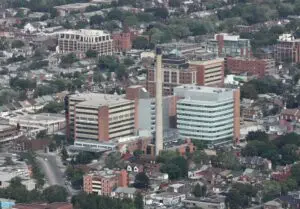Many buildings rely on purchasing and burning gas or other fossil fuels for heating. However, a cost-effective and eco-friendly alternative heat source is available: sewage pipes.
Sewage pipes carry not only wastewater but also a significant amount of excess heat generated by buildings, including warm water from activities like showers and dishwashers. For example, while the temperature outside the CBC building in Toronto was 0°C, the water inside nearby sewage pipes was around 17°C, according to the city. Typically, this valuable heat is wasted, but it doesn’t have to be.
Since 2010, Vancouver’s Southeast False Creek area has been utilizing heat from wastewater for space heating and hot water in buildings. The initiative now serves 4,920 residential units across 34 buildings and plans to expand further.
These projects use advanced technologies such as heat pumps, which can extract heat even from very cold air. They are most efficient when the heat source already contains a considerable amount of warmth, such as from the earth’s deep layers, a lake’s depths, or wastewater.
 Cities including Moncton, Charlottetown, and Toronto are exploring ways to harness this sustainable heat source. Notably, construction is underway on what is described as “the world’s largest raw wastewater energy project” at Toronto Western Hospital.
Cities including Moncton, Charlottetown, and Toronto are exploring ways to harness this sustainable heat source. Notably, construction is underway on what is described as “the world’s largest raw wastewater energy project” at Toronto Western Hospital.
The implementation is projected to cut greenhouse gas emissions by 8,400 tonnes annually, equivalent to removing 1,811 cars from the road. Additionally, by offering cooling during summer months, the system is estimated to conserve 250,000 cubic meters of water per year that would otherwise be lost through evaporation by the hospital’s chillers.
Adjacent to the hospital, a large pit about as wide as a helipad and roughly 13 stories deep is being constructed to tap into a major sewer pipe known as the Midtown Interceptor.
The wastewater will flow into heat exchangers to transfer its heat to clean water, which will then be extracted by heat pumps and transported to the hospital as hot water. This innovative approach is expected to save the hospital $685,000 annually in utility expenses.
Funded by Noventa and the Canadian Infrastructure Bank, this pioneering project in Toronto marks a first for the city. Its success has prompted city officials to explore similar opportunities throughout Toronto.
The feasibility of using sewage heat depends on factors such as the proximity of wastewater pipes to buildings, their size and flow rate, and water temperature. Fortunately, Toronto Water already possesses this crucial data for effective wastewater system management.
The city utilized the data to develop an innovative Wastewater Energy Map, which Nowlan considers to be a unique creation globally.
By inputting an address, the map displays the nearby pipe locations, flow volume, water temperature, and available heating and cooling capabilities in megawatts.
Since its launch in October 2022, the city has received approximately 20 inquiries from energy firms and engineering consultants involved in significant projects that could benefit from this energy source, as stated by Nowlan.
Leave a Reply